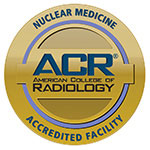


Austin Heart provides comprehensive diagnostic services, usually located within the physician office or in one of the five conveniently located imaging centers listed below.
Many procedures used to diagnose heart and vascular disease utilize some form of imaging. Austin Heart's echo, vascular and nuclear imaging departments have each received national accreditation from the Intersocietal Accreditation Commission. Less than five percent of cardiology practices, and only three practices in Texas, have been awarded all three accreditations.
Diagnostic Services Provided:
- Echocardiography: An echocardiogram is a test that uses ultrasound to create images of the heart. An ultrasound sends sound waves through the area of the body being studied to create images of internal body structures. The test is also known as an "echo."
- Positron Emission Tomography (PET):PET is a type of nuclear medicine imaging. The test is performed to allow cardiologists to evaluate the structure and function of the heart. PET uses a small amount of radioactive material called Rubidium to help produce three-dimensional images of the heart. PET delivers high quality images with high diagnostic accuracy.
- Attention Medicare Patients: Medicare requires you to have a physician visit within 30 days prior to your Nuclear Stress Test/PET Exam.
- Peripheral Artery Imaging - Carotid, Abdominal, Renal Artery and Lower Extremity Ultrasound: Peripheral arterial imaging is a test that provides your doctor with information about the condition of the arteries and veins outside of your heart using ultrasound to develop a 2 dimensional image and to evaluate the flow of blood through that vessel.
- Lower Extremity Peripheral Arterial Testing and Ankle-Brachial Index: Lower Extremity Peripheral Arterial testing provides your doctor with information about the condition of the arteries in your legs. Testing is performed when your doctor suspects that your symptoms might be caused by plaque (fatty buildup) in these arteries known as Peripheral Artery Disease (PAD).
- Myocardial Perfusion Test / Nuclear Stress Test: A Myocardial Perfusion Scan (also called a nuclear stress test) allows your doctor to see how your heart muscle works both when you are resting and when your heart is stressed. Your heart can be “stressed” with exercise on a treadmill or with drugs that increase the heart rate or change the way blood flows through the coronary arteries.
- Attention Medicare Patients: Medicare requires you to have a physician visit within 30 days prior to your Nuclear Stress Test/PET Exam.
- Vascular Advantage: Vascular Advantage is a three-part screening offered at Austin Heart to help assess your risk for stroke, an abdominal aortic aneurysm (AAA), and peripheral vascular disease (PAD). These affordable preventative screenings are convenient, non-invasive, and painless.
- Transesophageal Echocardiogram: A transesophageal echocardiogram (TEE) is a test that uses ultrasound waves to look at your heart from inside your chest. For this test, a small, flexible tube (or probe) with an ultrasound transducer at its tip is carefully placed in the esophagus to view the structures of the heart in a more comprehensive manner than a traditional transthoracic (through the chest wall) approach can provide. As this test is more invasive, patients are usually given medication to relax and sleep during the procedure.
- Exercise Stress Test: This is a test that uses an electrocardiogram (ECG or EKG) to record your heart’s electrical activity while walking on a treadmill. The test is performed to help evaluate chest pain and how your heart is functioning.
- Stress Echocardiogram: This is a test that allows your doctor to compare images of your heart muscle at rest with how it functions when stressed during exercise. Your heart rate is increased through exercise on a treadmill. In some cases, a drug is used to increase the heart rate rather than exercise. An echocardiogram is performed before you begin exercising and then immediately after you stop. Your heartbeat and blood pressure are also monitored during your stress echocardiogram.
- ECG or EKG: An electrocardiogram demonstrates how your heart's electrical system is working. The ECG senses and records the flow of electrical current through the muscle cells in your heart. The results are printed on a strip of paper or recorded electronically.
- Coronary CT Angiography (or CTA) is a diagnostic test that uses specialized x-ray beams to reconstruct and evaluate the structure and function of the heart, the coronary arteries, and the great vessels that lead to and from the heart.
- HeartSaver CTHeartSaver CT, which does not require a physician’s order, is an Ultrafast CT that provides sharp, clear images of the heart. These images can determine if there is abnormal calcium buildup in the coronary arteries which can indicate increased risk for heart attack. Early detection of heart disease is critical to prevent a heart attack before it occurs.
